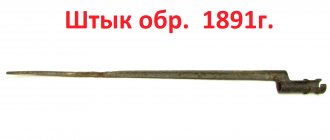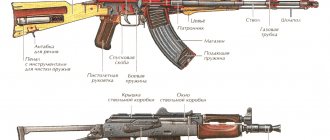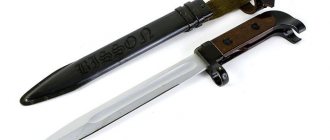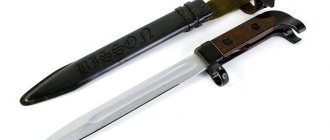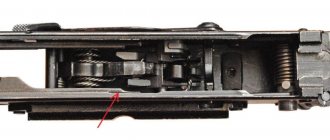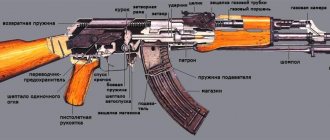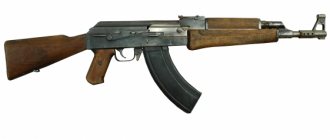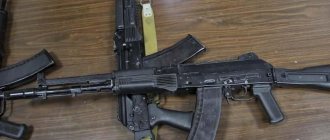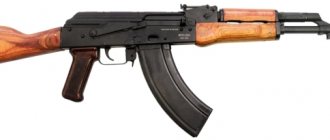Bayonet knives of Russia and the USSR
Already at this stage it becomes clear that we will be talking about a Russian bayonet for a Kalashnikov assault rifle. Its “evolution” includes many stages and experiments.
The results were both positive and negative. Things don’t always have to go “without a hitch.”
This is a normal and natural process when trying to achieve the best and most beneficial result possible. Let's try to look at the characteristics and capabilities of developments from different years.
Bayonet for SVD sniper rifle
Snipers in the Soviet army were armed with the SVD rifle. And their service involved engaging in hand-to-hand combat. They were also equipped with a 6X3 bayonet, but there was a difference in the color of the handle. Absolutely identical in all characteristics and functionality.
The bright orange handle was made dark cherry so as not to “glow” in position. The kit included a belt sheath, also similar in all respects to the previous version.
Read also: Temporary registration 2022
Experimental bayonet “Bumblebee”
Let’s say right away that the knife was not adopted for service, but it was able to show quite good results at the exhibition of the “Warrior” project. The conditions were:
- The bayonet must have an asymmetrical double-edged blade.
- With an impact of 40 J, it is possible to penetrate a bulletproof vest by 2 cm.
- Mandatory presence of wire cutters.
- The package must include a sharpening stone.
New bayonet knife Bumblebee.
The blade is coated with a matte finish, the handle is made of rubber with transverse grooves. The head of the handle has a T-shaped lock with an internal spring. Supplied with a very wide selection of sheaths. Total length 29.5 cm, blade 17 cm, blade width 3 cm.
Bayonet 6X3
Since 1959, the Soviet army began to use the modernized AKM Kalashnikov assault rifle, which replaced the basic AK. Along with the new firearms, the fighters also received a new bayonet - a 6X3 product was created specifically for the AKM. Several original ideas were used in the design of the bayonet and its scabbard, which significantly expanded the range of tasks performed. Due to several innovations, the 6X3 bayonet could be used not only in hand-to-hand combat or as a regular knife. The bayonet for the AKM assault rifle was not developed from scratch. The so-called knife of naval reconnaissance scuba divers, created by Lieutenant Colonel of the Naval Service R.M. Todorov. In the mid-fifties, this knife was offered to the command of the USSR Navy and even found limited use among the troops. The main feature of Todorov's knife was the design of the blade. It had a double-edged combat end with a concave upper blade. There was a serrated notch on the butt, and there was a rectangular hole in the middle part of the blade. The knife came with an additional blade in the form of a curved plate with a mount and a hook-blade. The fastener had to be inserted into the hole of the knife blade, after which the resulting structure could serve as a wire cutter.
AKM assault rifle with attached 6X3 bayonet and scabbard. Photo Oruzheika.mybb.ru
Gunsmiths from the M.T. team Kalashnikov had the opportunity to get acquainted with the “sea” knife and became interested in it. The result of this interest was the widespread borrowing of ideas and solutions from R.M.’s project. Todorova. The promising 6X3 bayonet for the AKM assault rifle was developed precisely on the basis of the naval reconnaissance knife. The resulting design turned out to be so successful that all subsequent domestic (as well as some foreign) bayonet-knives for machine guns had a characteristic shape and a special sheath that expanded the range of tasks to be solved.
By the mid-fifties, it became clear that the bayonet would now be used not only in fencing with weapons, but also for other purposes. It was assumed that such a weapon would also be used as a knife. The 6X3 project proposed to further expand the capabilities of the bayonet by borrowing and reworking Todorov’s original ideas. In particular, it was proposed to create a completely new sheath, which is not just a device for storing a blade, but a full-fledged element of a multifunctional complex designed for cutting various materials and objects.
The main part of the 6X3 bayonet was a blade with a length of 150 mm and a maximum width of 30 mm, created on the basis of the “sea” knife of Lieutenant Colonel Todorov. The blade received a combat end with a bevel and a double-edged sharpening. There was also a sharpening on the lower edge of the blade along its entire length. This blade design made it possible to deliver piercing and cutting blows. To solve additional problems, a rectangular hole was provided in the middle part of the blade, intended for connection with the sheath. There was a jagged notch on the butt.
Knife designed by R.M. Todorov, his sheath and device for cutting wire. Photo Rusknife.com
A crosspiece with a ring on the side of the main blade with a diameter of 17.7 mm was attached to the shank of the blade. On the side, the metal parts of the handle were covered with two plastic cheek pads with a characteristic round head. In the convex part of the head there was a groove in the form of an inverted “T” for mounting on the machine, as well as a spring-loaded latch. The latch was controlled using a button on the right side of the handle (when installing a bayonet on the machine gun). For additional ease of use, there were strap mounts on the handle and crosspiece.
To attach it to the machine gun, it was necessary to put the cross ring on the muzzle of the barrel, and also place the T-shaped protrusion on the barrel boss into the groove of the handle head. When the bayonet-knife was moved back, the ring sat on the barrel, and the protrusion entered the groove and was fixed with a latch. In this position the bayonet could be used in hand-to-hand combat. In the combat position of the bayonet, the blade was at the top, and the bevel of the butt with sharpening was at the bottom. The possibility of delivering piercing and cutting blows was provided.
The 6X3 bayonet had a total length of 280 mm with a 150 mm blade, which was noticeably different from previous types of edged weapons for small arms systems. In fact, it was the shortest bayonet for several decades or even several centuries, if you count early domestic needle bayonets. However, despite its relatively small size, this product fully complied with the requirements and could be used by the troops to solve a variety of combat and auxiliary tasks.
Bayonet 6X3. Photo Rusknife.com
Thanks to a special curved design, the R.M. Todorova could be used as wire cutters. The authors of the 6X3 project decided not to use individual parts and connect such a device with a scabbard, simplifying both the design of the weapon itself and its use. The main part of the sheath was a rectangular metal tube intended for storing the blade. On the top of this part there was a wide rubber pad that served as a handle. A leather loop was attached to the scabbard on the clip and carabiner for carrying on a belt. A part was attached to the lower part of the sheath with rivets, which served as an additional blade and was equipped with an axis for the knife.
Having a specific design and an unusual sheath, the 6X3 bayonet was a universal cutting tool. The main cutting edge made it possible to cut various materials, even metal. To cut some objects, it was proposed to use a serrator on the butt. Wire fences, including live ones, had to be cut using a sheath. To do this, it was proposed to fix the bayonet with its hole on the T-shaped support of the scabbard, after which the blade and the notch in the lower part of the scabbard could serve as wire cutters. The safety of cutting live wires was ensured by the plastic handle of the bayonet and the rubber lining of the sheath.
The production of 6X3 bayonet knives started in the late fifties, simultaneously with the start of assembly of AKM assault rifles. The main sites for the production of these weapons were the Izhevsk and Tula arms factories. Modernized Kalashnikov assault rifles were supplied to the troops from the very beginning along with new bayonets. For this reason, in particular, there were no problems with retrofitting the weapon, as was the case with the AK assault rifle and the 6X2 bayonet. In addition, there were no compatibility problems, since the design of the machine gun and bayonet mounts were developed simultaneously. The number of machine guns and bayonets produced by Soviet industry was approximately equal.
The bayonet is in the scabbard, the rubber pad and the device for cutting wire on the scabbard are clearly visible. Photo Rusknife.com
Some time after the start of operation of the AKM in the Soviet army, the USSR industry transferred documentation for the production of these weapons to several friendly countries. Thus, machine guns and bayonets of the 6X3 type were produced not only in our country, but also abroad. Taking into account foreign weapons, the total number of 6X3 bayonets reaches several million units.
The 6X3 bayonet was originally developed for the AKM assault rifle, but later it began to be used with other weapons. In 1963, the Dragunov SVD sniper rifle was adopted for service, which was also proposed to be equipped with a bayonet. The design of the muzzle and barrel beads of this weapon was developed taking into account the use of a 6X3 bayonet. To attach it, the muzzle of the barrel of the required diameter and the bead on the lower part of the barrel were used. For obvious reasons, the sniper rifle was almost never used with a bayonet, which is why the latter served as a knife and complemented the sniper’s equipment.
With the adoption of the 6X3 bayonet, for the first time in domestic practice, the army received not just a weapon for bayonet fighting, but a full-fledged multifunctional cutting tool for solving various tasks. Depending on the situation and need, the 6X3 product could be used in hand-to-hand combat, at home, or for various auxiliary work, such as preparing passages in enemy barriers. The bayonets of previous models differed from the new 6X3 in less versatility. They could be used in hand-to-hand combat or, in some cases, as knives, but the scope of possible applications was noticeably smaller due to the lack of serrated serrations and sheaths with special equipment.
Demonstration of the use of a 6X3 bayonet with a sheath as a wire cutter. Photo: Wikimedia Commons
Using the redesigned and improved design of Lieutenant Colonel Todorov's knife allowed the engineers from M.T.'s team. Kalashnikov not only created a bayonet for a new machine gun, but also laid the foundations for a whole family of edged weapons. Subsequently, on the basis of the 6X3 bayonet, several new models of similar weapons were developed for additional equipment of machine guns. They received new handle designs, updated sheaths, etc., but the design of the blade and the main ideas of the projects remained unchanged. Thus, the bayonets currently used are a direct development of additional weapons for the AKM. In addition, a number of armies around the world still use the original 6X3.
Considering the number of 6X3 products produced, as well as new models based on them, it can be argued that this was one of the most successful and numerous bayonet knives in the world. “Marine” knife designed by R.M. Todorov was not widely used, but the bayonet-knife created on its basis for the AKM assault rifle was produced in large quantities and was used by many armies. All this speaks of the perfection of the two samples and the correctness of the chosen approach to the development of new weapons, which has fully justified itself.
Based on materials from the sites: https://bayonet.lv/ https://bratishka.ru/ https://rusknife.com/ https://world.guns.ru/
SKS bayonet and its features
After the end of the Second World War, the Simonov self-loading carbine was adopted by the USSR army. The results of the Second World War showed that the removable bayonet-knife has some disadvantages, so they decided to equip the new weapon with a folding, permanent bayonet that does not interfere with transportation. SKS bayonets were produced in two types: needle and knife. This mounting design has not yet been used in the history of Russian weapons, so there were many opponents of folding models.
Needle bayonets
At the end of the XVII-XVIII centuries. a new revolution took place in military affairs, and mounts completely fell out of use. This is due to the appearance of needle bayonets, which were triangular or T-shaped in cross-section. And they were located with the flat side parallel to the trunk. This decision was due to the fact that the firearm was loaded from the side of the barrel, and if there was a sharp cutting edge located close to the barrel, the fighter could easily injure his hand.
Due to the fact that the bayonet was a simple needle, with a round base tube, it was fashionable to fully use the weapon, both for shooting and in hand-to-hand combat. Which of course increased the effectiveness of the battle.
The famous bayonet for the Mosin rifle
The first bayonets for the Mosin rifle appeared before the start of the First World War. If you look up the archival documents of those years, you can see that initially it was proposed to make the Mosin bayonet a knife type. However, supporters of classic needle weapons managed to insist on the old design. Mosin rifles continued to be produced in the USSR after the Civil War, with several bayonet upgrades.
It should be noted that in the USSR they mainly modernized the bayonet mount, leaving its shape unchanged. During the Great Patriotic War, bayonets with knife or even dagger blades appeared, but these were homemade.
